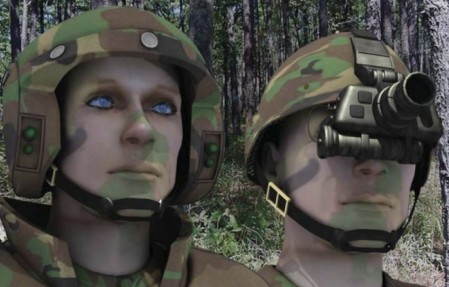
Drugs that make soldiers want to fight. Robots linked directly to their controllers’ brains. Lie-detecting scans administered to terrorist suspects as they cross U.S. borders.
These are just a few of the military uses imagined for cognitive science — and if it’s not yet certain whether the technologies will work, the military is certainly taking them very seriously.
“It’s way too early to know which — if any — of these technologies is going to be practical,” said Jonathan Moreno, a Center for American Progress bioethicist and author of Mind Wars: Brain Research and National Defense. “But it’s important for us to get ahead of the curve. Soldiers are always on the cutting edge of new technologies.”
Moreno is part of a National Research Council committee convened by the Department of Defense to evaluate the military potential of brain science. Their report, “Emerging Cognitive Neuroscience and Related Technologies,” was released today. It charts a range of cognitive technologies that are potentially powerful — and, perhaps, powerfully troubling.
Here are the report’s main areas of focus:
- Mind reading. The development of psychological models and neurological imaging has made it possible to see what people are thinking and whether they’re lying. The science is, however, still in its infancy: Challenges remain in accounting for variations between individual brains, and the tendency of our brains to change over time.One important application is lie detection — though one hopes that the lesson of traditional lie detectors, predicated on the now-disproven idea that the physiological basis of lying can be separated from processes such as anxiety, has been learned.
Mind readers could be used to interrogate captured enemies, as well as “terrorist suspects” passing through customs. But does this mean, for example, that travelers placed on the bloated, mistake-laden watchlist would have their minds scanned, just as their computers will be?
The report notes that “In situations where it is important to win the hearts and minds of the local populace, it would be useful to know if they understand the information being given them.”
- Cognitive enhancement. Arguably the most developed area of cognitive neuroscience, with drugs already allowing soldiers to stay awake and alert for days at a time, and brain-altering drugs in widespread use among civilians diagnosed with mental and behavioral problems.Improved drug delivery systems and improved neurological understanding could make today’s drugs seem rudimentary, giving soldiers a superhuman strength and awareness — but if a drug can be designed to increase an ability, a drug can also be designed to destroy it.
“It’s also important to develop antidotes and protective agents against various classes of drugs,” says the report. This echoes the motivation of much federal biodefense research, in which designing defenses against potential bioterror agents requires those agents to be made — and that raises the possibility of our own weapons being turned against us, as with the post-9/11 anthrax attacks, which used a military developed strain.
- Mind control. Largely pharmaceutical, for the moment, and a natural outgrowth of cognitive enhancement approaches and mind-reading insight: If we can alter the brain, why not control it?One potential use involves making soldiers want to fight. Conversely, “How can we disrupt the enemy’s motivation to fight? […] How can we make people trust us more? What if we could help the brain to remove fear or pain? Is there a way to make the enemy obey our commands?”
- Brain-Machine Interfaces. The report focuses on direct brain-to-machine systems (rather than, for example, systems that are controlled by visual movements, which are already in limited use by paraplegics.) Among these are robotic prostheses that replace or extend body parts; cognitive and sensory prostheses, which make it possible to think and to perceive in entirely new ways; and robotic or software assistants, which would do the same thing, but from a distance.Many questions surrounding the safety of current brain-machine interfaces: The union of metal and flesh only lasts so long before things break down. But assuming those can be overcome, questions of plasticity arise: What happens when a soldier leaves the service? How might their brains be reshaped by their experience?
Like Moreno said, it’s too early to say what will work. The report documents in great detail the practical obstacles to these aims — not least the failure of reductionist neuroscientific models, in which a few firing neurons can be easily mapped to a psychological state, and brains can be analyzed in one-map-fits-all fashion.
But given the rapid progress of cognitive science, it’s foolish to assume that obstacles won’t be overcome. Hugh Gusterson, a George Mason University anthropologist and critic of the military’s sponsorship of social science research, says their attempt to crack the cultural code is unlikely to work — “but my sense with neuroscience,” he said, “is a far more realistic ambition.”
Gusterson is deeply pessimistic about military neuroscience, which will not be limited to the United States.
“I think most reasonable people, if they imagine a world in which all sides have figured out how to control brains, they’d rather not go there,” he said. “Most rational human beings would believe that if we could have a world where nobody does military neuroscience, we’ll all be better off. But for some people in the Pentagon, it’s too delicious to ignore.”
Emerging Cognitive Neuroscience and Related Technologies [National Academies Press]
Image: University of Western Florida
Note: The NRC committee is formally known as the Committee on Military and Intelligence Methodology for Emergent Neurophysiological and Cognitive/Neural Science Research in the Next Two Decades. In the future, cognitive technologies will apparently obviate the need for snappy, easily-acronymed titles.
By Brandon Keim
August 13, 2008
Source: Wired